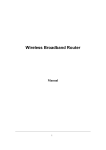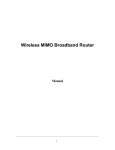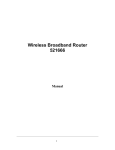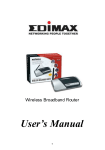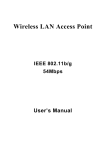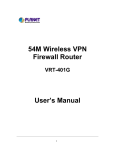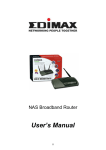Download Sitecom Wireless Router 54g
Transcript
WL-600 Wireless Broadband Router (802.11bg) 1 2 Introduction Congratulations on purchasing this Wireless Broadband Router. This Wireless Broadband Router is a cost-effective IP Sharing Router that enables multiple users to share the Internet through an ADSL or cable modem. Simply configure your Internet connection settings in the Wireless Broadband Router and plug your PC to the LAN port and you're ready to share files and access the Internet. As your network grows, you can connect another hub or switch to the router’s LAN ports, allowing you to easily expand your network. The Wireless Broadband Router is embedded with a IEEE 802.11g/b access point that allows you to build up a wireless LAN. The Wireless Broadband Router provides a total solution for the Small and Medium-sized Business (SMB) and the Small Office/Home Office (SOHO) markets, giving you an instant network today, and the flexibility to handle tomorrow's expansion and speed. Features • • • • • • • • • • • • High Internet Access throughput (50M) Allow multiple users to share a single Internet line Supports up to 253 users Internet Access via Cable or xDSL modem Access Private LAN Servers from the Public Network Equipped with four LAN ports (10/100M) and one WAN port (10/100M) Provides IEEE 802.11g/b wireless LAN access point Support DHCP (Server/Client) for easy setup Support advance features such as: Special Applications, DMZ, Virtual Servers, Access Control, Firewall. Allow you to monitor the router’s status such as: DHCP Client Log, System Log, Security Log and Device/Connection Status Easy to use Web-based GUI for configuration and management purposes Remote Management allows configuration and upgrades from a remote site (over the Internet) Minimum Requirements • • • One External xDSL (ADSL) or Cable modem with an Ethernet port (RJ-45) Network Interface Card (NIC) for each Personal Computer (PC) PCs with a Web-Browser (Internet Explorer 4.0 or higher, or Netscape Navigator 4.7 or higher) Package Content • • • • • One 4-port Broadband router unit One Quick Installation Guide One User Manual CD One Power Adapter Accessories Note The WAN “idle timeout” auto-disconnect function may not work due to abnormal activities of some network application software, computer virus or hacker attacks from the Internet. For example, some software sends network packets to the Internet in the background, even when you are not using the Internet. So please turn off your computer when you are not using it. This function also may not work with some ISP. So please make sure this function can work properly when you use this function in the first time, especially your ISP charge you by time used. 3 Get to know the Broadband Router Back Panel The diagram (fig1.0) below shows the broadband router’s back panel. The router’s back panel is divided into three sections, LAN, WAN and Reset: Figure 1.0 1) Local Area Network (LAN) The Broadband router’s 4 LAN ports are where you connect your LAN’s PCs, printer servers, hubs and switches etc. 2) Wide Area Network (WAN) The WAN port is the segment connected to your xDSL or Cable modem and is linked to the Internet. 3) Reset The Reset button allows you to do one of two things. 1) If problems occur with your router, press the router’s reset button with a pencil tip (for less than 4 seconds) and the router will re-boot itself, keeping your original configurations. 2) If problems persist or you experience extreme problems or you forgot your password, press the reset button for longer than 4 seconds and the router will reset itself to the factory default settings (warning: your original configurations will be replaced with the factory default settings) 4 Front Panel On the router’s front panel there are LED lights that inform you of the router’s current status. Below is an explanation of each LED and its description. LED Light Status: Description PWR ON: Router’s power supply is on WAN 10/100M ON: WAN port 100Mbps is connected OFF: WAN port 10Mbps is connected ON: WAN is connected OFF: No WAN connection Flashing: WAN port has Activity (ACT), data being sent WAN LNK/ACT LAN 10/100M ON: LAN port 100Mbps is connected OFF:LAN port 10Mbps is connected ON: LAN is connected OFF:No LAN connection Flashing: LAN port has Activity (ACT), data being sent (Port 1-4) LAN LNK/ACT (Port 1-4) 802.11G ON: Wireless LAN has been activated OFF:Wireless LAN is disabled Flashing: Wireless LAN has Activity (ACT) data being sent 5 Setup Diagram Figure 1.2 below shows a typical setup for a Local Area Network (LAN). Figure 1.2 6 Getting started This is a step-by-step instruction on how to start using the router and get connected to the Internet. 1) Setup your network as shown in the setup diagram above (fig 1.2). 2) You then need to set your LAN PC clients so that it can obtain an IP address automatically. All LAN clients require an IP address. Just like an address, it allows LAN clients to find one another. (If you have already configured your PC to obtain an IP automatically then proceed to step 3, page 11) Configure your PC to obtain an IP address automatically By default the broadband router’s DHCP is on, this means that you can obtain an IP address automatically once you’ve configured your PC to obtain an IP address automatically. This section will show you how to configure your PC’s so that it can obtain an IP address automatically for either Windows 95/98/Me, 2000 or NT operating systems. For other operating systems (Macintosh, Sun, etc.), follow the manufacturer’s instructions. The following is a step-by-step illustration on how to configure your PC to obtain an IP address automatically for 2a) Windows 95/98/Me, 2b) Windows XP, 2c) Windows 2000 and 2d) Windows NT. 2a) Windows 95/98/Me 1: Click the Start button and select Settings, then click Control Panel. The Control Panel window will appear. 2: Double-click Network icon. The Network window will appear. 3: Check your list of Network Components. If TCP/IP is not installed, click the Add button to install it now. If TCP/IP is installed, go to step 6. 4: In the Network Component Type dialog box, select Protocol and click Add button. 7 5: In the Select Network Protocol dialog box, select Microsoft and TCP/IP and then click the OK button to start installing the TCP/IP protocol. You may need your Windows CD to complete the installation. 6: After installing TCP/IP, go back to the Network dialog box. Select TCP/IP from the list of Network Components and then click the Properties button. 7: Check each of the tabs and verify the following settings: • • • • • Bindings: Check Client for Microsoft Networks and File and printer sharing for Microsoft Networks. Gateway: All fields are blank. DNS Configuration: Select Disable DNS. WINS Configuration: Select Disable WINS Resolution. IP Address: Select Obtain IP address automatically. 8: Reboot the PC. Your PC will now obtain an IP address automatically from your Broadband Router’s DHCP server. Note: Please make sure that the Broadband router’s DHCP server is the only DHCP server available on your LAN. Once you’ve configured your PC to obtain an IP address automatically, please proceed to Step 3 2b) Windows XP 1: Click the Start button and select Settings, then click Network Connections. The Network Connections window will appear. 8 2: Double-click Local Area Connection icon. The Local Area Connection window will appear. 3: Check your list of Network Components. You should see Internet Protocol [TCP/IP] on your list. Select it and click the Properties button. 4: In the Internet Protocol (TCP/IP) Properties window, select Obtain an IP address automatically and Obtain DNS server address automatically as shown on the following screen. 5: Click OK to confirm the setting. Your PC will now obtain an IP address automatically from your Broadband Router’s DHCP server. Note: Please make sure that the Broadband router’s DHCP server is the only DHCP server available on your LAN. Once you’ve configured your PC to obtain an IP address automatically, please proceed to Step 3. 2c) Windows 2000 1: Click the Start button and select Settings, then click Control Panel. The Control Panel window will appear. 9 2: Double-click Network and Dial-up Connections icon. In the Network and Dial-up Connection window, double-click Local Area Connection icon. The Local Area Connection window will appear. 3: In the Local Area Connection window, click the Properties button. 4: Check your list of Network Components. You should see Internet Protocol [TCP/IP] on your list. Select it and click the Properties button. 5: In the Internet Protocol (TCP/IP) Properties window, select Obtain an IP address automatically and Obtain DNS server address automatically as shown on the following screen. 6: Click OK to confirm the setting. Your PC will now obtain an IP address automatically from your Broadband Router’s DHCP server. Note: Please make sure that the Broadband router’s DHCP server is the only DHCP server available on your LAN. Once you’ve configured your PC to obtain an IP address automatically, please proceed to Step 3. 2d) Windows NT 10 1: Click the Start button and select Settings, then click Control Panel. The Control Panel window will appear. 2: Double-click Network icon. The Network window will appear. Select the Protocol tab from the Network window. 3: Check if the TCP/IP Protocol is on your list of Network Protocols. If TCP/IP is not installed, click the Add button to install it now. If TCP/IP is installed, go to step 5. 4: In the Select Network Protocol window, select the TCP/IP Protocol and click the Ok button to start installing the TCP/IP protocol. You may need your Windows CD to complete the installation. 5: After you install TCP/IP, go back to the Network window. Select TCP/IP from the list of Network Protocols and then click the Properties button. 6: Check each of the tabs and verify the following settings: • IP Address: Select Obtain an IP address from a DHCP server. • DNS: Let all fields are blank. • WINS: Let all fields are blank. • Routing: Let all fields are blank. 11 7: Click OK to confirm the setting. Your PC will now obtain an IP address automatically from your Broadband Router’s DHCP server. Note: Please make sure that the Broadband router’s DHCP server is the only DHCP server available on your LAN. Once you’ve configured your PC to obtain an IP address automatically, please proceed to Step 3. 3) Once you have configured your PCs to obtain an IP address automatically, the router’s DHCP server will automatically give your LAN clients an IP address. By default the Broadband Router’s DHCP server is enabled so that you can obtain an IP address automatically. To see if you have obtained an IP address, see Appendix A. Note: Please make sure that the Broadband router’s DHCP server is the only DHCP server available on your LAN. If there is another DHCP on your network, then you’ll need to switch one of the DHCP servers off. (To disable the Broadband router’s DHCP server see chapter 2 LAN Port) 4) Once your PC has obtained an IP address from your router, enter the default IP address 192.168.0.1 (broadband router’s IP address) into your PC’s web browser and press <enter> 5) The login screen below will appear. Enter the “User Name” and “Password” and then click <OK> to login. Note: By default the user name is “admin” and the password is “admin”. For security reasons it is recommended that you change the password as soon as possible (in General setup/system/password, see chapter 2) 12 The HOME page screen below will appear. Menu Description Home (Chapter 1) In this section you can see the Broadband router's system information, Internet Connection, 13 Device Status, System Log, Security Log and DHCP client information. Wizard (Chapter 2) Select your Internet connection type and then input the configurations needed to connect to your Internet Service Provider (ISP). Wireless Settings (Chapter 3) This section contains the wireless settings and allows you to configure the AP settings and security. This section also contains Site Survey to find wireless networks in the neighborhood, and WDS settings. Firewall (Chapter 4) This section contains configurations for the Broadband router’s advance functions such as: Virtual Server, Access Control, Hacker Attack Prevention, DMZ, Special applications and other functions to meet your LAN requirements. Toolbox This section contains the broadband router’s Tools - Tools include Configuration tools, Firmware upgrade and Reset. Configuration tools allow you to Backup (save), Restore, or Restore to Factory Default configuration for your Broadband router. The Firmware upgrade tool allows you to upgrade your Broadband router's firmware. The RESET tool allows you to reset your Broadband router. 7) Click on Wizard (see chapter 2) to start configuring settings required by your ISP so that you can start accessing the Internet. 8) It’s also highly recommended to setup encryption for your wireless network. Go to Wireless Settings, and click on Security to change the encryption options in the router. 14 Chapter 1: Home 1.1 Status The Status section allows you to monitor the current status of your router. You can use the Status page to monitor: the connection status of the Broadband router's WAN/LAN interfaces, the current firmware and hardware version numbers, any illegal attempts to access your network, and information on all DHCP client PCs currently connected to your network. Parameters 1.1 Status Description and Information Shows the router’s system information, the current internet connection status, wireless configuration status, and other related information. 1.2 LAN Settings Shows the LAN settings, and allows the user to change LAN settings. 1.3 DHCP View your LAN client's information that is currently linked to the Broadband router's DHCP server 1.4 Log View the Broadband router’s system log 1.5 Statistics Shows the statistics 15 1.2 LAN The LAN Port screen below allows you to specify a private IP address for your router’s LAN ports as well as a subnet mask for your LAN segment. Parameters Default Description IP address 192.168.0.1 IP Subnet Mask 255.255.255.0 Specify a Subnet Mask for your LAN segment 802.1d Spanning Tree Disabled If 802.1d Spanning Tree function is enabled, this router will use the spanning tree protocol to prevent from network loop happened in the LAN ports. DHCP Server Enabled You can enable or disable the DHCP server. By enabling the DHCP server the router will automatically give your LAN clients an IP address. If the DHCP is not enabled then you’ll have to manually set your LAN client’s IP addresses; make sure the LAN Client is in the same subnet as this broadband router if you want the router to be your LAN client’s default gateway This is the router’s LAN port IP address (Your LAN clients default gateway IP address) 16 Lease Time The DHCP when enabled will temporarily give your LAN clients an IP address. In the Lease Time setting you can specify the time period that the DHCP lends an IP address to your LAN clients. The DHCP will change your LAN client’s IP address when this time threshold period is reached DHCP Client Range You can select a particular IP address range for your DHCP server to issue IP addresses to your LAN Clients. Note: By default the IP range is from: Start IP 192.168.0.100 to End IP 192.168.0.199. If you want your PC to have a static/fixed IP address then you’ll have to choose an IP address outside this IP address Pool Domain Name You can specify a Domain Name for your LAN Click <Apply> at the bottom of the screen to save the above configurations. You can now configure other advance sections or start using the router (with the advance settings in place) 17 1.3 Active DHCP Client View your LAN client's information that is currently linked to the Broadband router's DHCP server Parameters Description Active DHCP Client This page shows all DHCP clients (LAN PCs) currently connected to your network. The “Active DHCP Client Table” displays the IP address and the MAC address and Time Expired of each LAN Client. Use the Refresh button to get the most updated situation 18 1.4 System Log View the operation log of the system. Parameters Description System Log This page shows the current system log of the Broadband router. It displays any event occurred after system start up. At the bottom of the page, the system log can be saved <Save> to a local file for further processing or the system log can be cleared <Clear> or it can be refreshed <Refresh> to get the most updated situation. When the system is powered down, the system log will disappear if not saved to a local file. 19 1.5 Statistics View the statistics of packets sent and received on WAN, LAN and Wireless LAN. Parameters Statistics Description Shows the counters of packets sent and received on WAN, LAN and Wireless LAN. 20 Chapter 2: Wizard • Click Wizard to configure the router. • The Setup wizard will now be displayed; check that the modem is connected and click Next. • Select your country from the Country list. • From Service, select your internet provider. Click Next. 21 • Depending on the chosen provider, you may need to enter your user name and password, MAC address or hostname in the following window. After you have entered the correct information, click Next. • Click OK to complete the configuration. • Wait for about 10 seconds to allow the router to connect to the Internet. 22 Chapter 3: Wireless Settings 3.1 Wireless Basic Settings Wireless Access Point builds a wireless LAN and can let all PCs equipped with IEEE 802.11b or 801.11g wireless network adaptor connect to your Intranet. It supports WEP and WPA2 encryption to enhance the security of your wireless network. Parameters Default Description Disable wireless interface Disabled You can select to enable or disable the wireless access point module of this router. Mode It allows you to set the AP to AP, Station, Bridge or WDS mode. Band It allows you to set the AP fix at 802.11b or 802.11g mode. You also can select B+G mode to allow the AP select 802.11b and 802.11g connection automatically. ESSID Sitecom This is the name of the wireless LAN. All the devices in the same wireless LAN should have the same ESSID. Channel Number 11 The channel used by the wireless LAN. All devices in the same wireless LAN should use the same channel. 23 Associated Clients Click “Show Active Clients” button, then an “Active Wireless Client Table” will pop up. You can see the status of all active wireless stations that are connecting to the access point. WLAN MAC This is the MAC address used by the Wireless interface of this AP when it is in the station modes. Clone MAC Click the “Clone MAC” button will copy the MAC address of your PC, that you are using to configure the AP, to the WLAN MAC. MAC address If you want to bridge more than one networks together with wireless LAN, you have to set this access point to “AP Bridge-Point to Point mode”, “AP Bridge-Point to Multi-Point mode” or “AP Bridge-WDS mode”. You have to enter the MAC addresses of other access points that join the bridging work. Set Security Click the “Set Security” button, then a “WDS Security Settings” will pop up. You can set the security parameters used to bridge access points together here when your AP is in AP Bridge modes. You can refer to section 4.3 “Security Settings” for how to set the parameters. Click <Apply> at the bottom of the screen to save the above configurations. You can now configure other advance sections or start using the router (with the advance settings in place) 24 3.2 Advanced Settings You can set advanced wireless LAN parameters of this router. The parameters include Authentication Type, Fragment Threshold, RTS Threshold, Beacon Interval, Preamble Type …… You should not change these parameters unless you know what effect the changes will have on this router. Parameters Description Authentication Type There are two authentication types: "Open System" and "Shared Key". When you select "Open System", wireless stations can associate with this wireless router without WEP encryption. When you select "Shared Key", you should also setup WEP key in the "Encryption" page and wireless stations should use WEP encryption in the authentication phase to associate with this wireless router. If you select "Auto", the wireless client can associate with this wireless router by using any one of these two authentication types. Fragment Threshold "Fragment Threshold" specifies the maximum size of packet during the fragmentation of data to be transmitted. If you set this value too low, it will result in bad performance. RTS Threshold When the packet size is smaller the RTS threshold, the wireless router will not use the RTS/CTS mechanism to send this packet. 25 Beacon Interval The interval of time that this wireless router broadcast a beacon. Beacon is used to synchronize the wireless network. Data Rate The “Data Rate” is the rate this access point uses to transmit data packets. The access point will use the highest possible selected transmission rate to transmit the data packets. Preamble Type The “Long Preamble” can provide better wireless LAN compatibility while the “Short Preamble” can provide better wireless LAN performance. Broadcast ESSID If you enable “Broadcast ESSID”, every wireless station located within the coverage of this access point can discover this access point easily. If you are building a public wireless network, enabling this feature is recommended. Disabling “Broadcast ESSID” can provide better security. IAPP If you enable “IAPP”, it will allow wireless station roaming between IAPP enabled access points within the same wireless LAN. 802.11g Protection This is also called CTS Protection. It is recommended to enable the protection mechanism. This mechanism can decrease the rate of data collision between 802.11b and 802.11g wireless stations. When the protection mode is enabled, the throughput of the AP will be a little lower due to many of frame traffic should be transmitted. Click <Apply> at the bottom of the screen to save the above configurations. You can now configure other advance sections or start using the router. 26 3.3 Security This Access Point provides complete wireless LAN security functions, include WEP, IEEE 802.11x, IEEE 802.11x with WEP, WPA with pre-shared key and WPA with RADIUS. With these security functions, you can prevent your wireless LAN from illegal access. Please make sure your wireless stations use the same security function. 3.3.1 WEP only When you select 64-bit or128-bit WEP key, you have to enter WEP keys to encrypt data. You can generate the key by yourself and enter it. You can enter four WEP keys and select one of them as default key. Then the router can receive any packets encrypted by one of the four keys Parameters Description Key Length You can select the WEP key length for encryption, 64-bit or 128-bit. Larger WEP key length will provide higher level of security, but the throughput will be lower. Key Format You may select to select ASCII Characters (alphanumeric format) or Hexadecimal Digits (in the "A-F", "a-f" and "0-9" range) to be the WEP Key. For example: ASCII Characters: guest 27 Hexadecimal Digits: 12345abcde Default Key Select one of the four keys to encrypt your data. Only the key you select it in the "Default key" will take effect. Key 1 - Key 4 The WEP keys are used to encrypt data transmitted in the wireless network. Fill the text box by following the rules below. 64-bit WEP: input 10-digit Hex values (in the "AF", "a-f" and "0-9" range) or 5-digit ASCII character as the encryption keys. 128-bit WEP: input 26-digit Hex values (in the "A-F", "a-f" and "0-9" range) or 13-digit ASCII characters as the encryption keys. Click <Apply> at the bottom of the screen to save the above configurations. You can now configure other advance sections or start using the router (with the advance settings in place) 3.3.2 802.1x only IEEE 802.1x is an authentication protocol. Every user must use a valid account to login to this Access Point before accessing the wireless LAN. The authentication is processed by a RADIUS server. This mode only authenticates user by IEEE 802.1x, but it does not encryption the data during communication. Parameters Description RADIUS Server IP address The IP address of external RADIUS server. RADIUS Server Port The service port of the external RADIUS server. RADIUS Server Password The password used by external RADIUS server. Click <Apply> at the bottom of the screen to save the above configurations. You can now configure other advance sections or start using the router (with the advance settings in place) 3.3.3 802.1x WEP Static key IEEE 802.1x is an authentication protocol. Every user must use a valid account to login to this Access Point before accessing the wireless LAN. The authentication is processed by a RADIUS server. This mode also uses WEP to encrypt the data during communication. For the WEP settings, please refer to section 2.4.3.1 “WEP only”. For the 802.1x settings, please refer to section 2.4.3.2 “802.1x only”. 28 3.3.4 WPA Pre-shared key Wi-Fi Protected Access (WPA) is an advanced security standard. You can use a pre-shared key to authenticate wireless stations and encrypt data during communication. It uses TKIP or CCMP(AES) to change the encryption key frequently. So the encryption key is not easy to be broken by hackers. This can improve security very much. Parameters Description WPA(TKIP) TKIP can change the encryption key frequently to enhance the wireless LAN security. WPA2(AES) This use CCMP protocol to change encryption key frequently. AES can provide high level encryption to enhance the wireless LAN security. WPA2 Mixed This will use TKIP or AES based on the other communication peer automatically. Pre-shared Key Format You may select to select Passphrase (alphanumeric format) or Hexadecimal Digits (in the “A-F”, “a-f” and “0-9” range) to be the Preshared Key. For example: Passphrase: iamguest Hexadecimal Digits: 12345abcde Pre-shared Key The Pre-shared key is used to authenticate and encrypt data transmitted in the wireless network. Fill the text box by following the rules below. Hex WEP: input 64-digit Hex values (in the “AF”, “a-f” and “0-9” range) or at least 8 character pass phrase as the pre-shared keys. Click <Apply> at the bottom of the screen to save the above configurations. You can now configure other advance sections or start using the router (with the advance settings in place) 3.3.5 WPA Radius Wi-Fi Protected Access (WPA) is an advanced security standard. You can use an external RADIUS server to authenticate wireless stations and provide the session key to encrypt data during communication. It uses TKIP or CCMP(AES) to change the encryption key frequently. This can improve security very much. Parameters Description WPA(TKIP) TKIP can change the encryption key frequently to enhance the wireless LAN security. 29 WPA2(AES) This use CCMP protocol to change encryption key frequently. AES can provide high level encryption to enhance the wireless LAN security. WPA2 Mixed This will use TKIP or AES based on the other communication peer automatically. RADIUS Server IP address The IP address of external RADIUS server. RADIUS Server Port The service port of the external RADIUS server. RADIUS Server Password The password used by external RADIUS server. Click <Apply> at the bottom of the screen to save the above configurations. You can now configure other advance sections or start using the router (with the advance settings in place) 30 3.4 Access Control This wireless router provides MAC Address Control, which prevents the unauthorized MAC Addresses from accessing your wireless network. Parameters Description Enable wireless access control Enable wireless access control Add MAC address into the list Fill in the "MAC Address" and "Comment" of the wireless station to be added and then click "Add". Then this wireless station will be added into the "Current Access Control List" below. If you find any issues before adding it and want to retype again. Just click "Clear" and both "MAC Address" and "Comment" fields will be cleared. Remove MAC address from the list If you want to remove some MAC address from the "Current Access Control List ", select the MAC addresses you want to remove in the list and then click "Delete Selected". If you want remove all MAC addresses from the table, just click "Delete All" button. Click "Reset" will clear your current selections. Click <Apply> at the bottom of the screen to save the above configurations. You can now configure other advance sections or start using the router (with the advance settings in place) 31 3.5 Site Survey This page provides a tool to scan the wireless network. If any Access Point or IBSS is found, you can choose to connect it manually when client mode is enabled. 32 3.6 WDS Wireless Distribution System uses wireless media to communicate with other APs. To use WDS, you must set these APs in the same channel and set MAC addresses of other APs which you want to communicate with in the table and then enable the WDS. Click the ‘Set Security’ button to change security options. 33 Chapter 4: Firewall 4.1 Port Filtering The WL-161 offers the option to filter certain ranges of ports on your local area network. Select ‘Enable Port Filtering’ to enable the port filter option, and enter a port range in the appropriate box. 34 4.2 IP Filtering The WL-161 offers the option to filter UDP or TCP traffic for certain IP addresses on your local area network. Select ‘Enable IP Filtering’ to enable the IP filter option, and enter a local IP address in the appropriate box. 35 4.3 MAC Filtering This wireless router provides MAC Address Control, which prevents the unauthorized MAC Addresses from accessing your network. 36 4.4 Port Forwarding The Port Forwarding allows you to re-direct a particular range of service port numbers (from the Internet/WAN Ports) to a particular LAN IP address. It help you to host some servers behind the router NAT firewall. Parameter Description Enable Port Forwarding Enable Port Forwarding IP Address This is the private IP of the server behind the NAT firewall. Note: You need to give your LAN PC clients a fixed/static IP address for Port Forwarding to work properly. Protocol This is the protocol type to be forwarded. You can choose to forward “TCP” or “UDP” packets only or select “both” to forward both “TCP” and “UDP” packets. Port Range The range of ports to be forward to the private IP. Comment The description of this setting. Add Port Forwarding into the table Fill in the "Private IP", “Type”, “Port Range” and "Comment" of the setting to be added and then click "Add". Then this Port Forwarding setting will be added into the "Current Port Forwarding 37 Table" below. If you find any typo before adding it and want to retype again, just click "Clear" and the fields will be cleared. Remove Port Forwarding into the table If you want to remove some Port Forwarding settings from the " Current Port Forwarding Table", select the Port Forwarding settings you want to remove in the table and then click "Delete Selected". If you want remove all Port Forwarding settings from the table, just click "Delete All" button. Click "Reset" will clear your current selections. Click <Apply> at the bottom of the screen to save the above configurations. You can now configure other advance sections or start using the router (with the advance settings in place) 38 4.5 DMZ If you have a local client PC that cannot run an Internet application (e.g. Games) properly from behind the NAT firewall, then you can open the client up to unrestricted two-way Internet access by defining a DMZ Host. The DMZ function allows you to re-direct all packets going to your WAN port IP address to a particular IP address in your LAN. The difference between the virtual server and the DMZ function is that the virtual server re-directs a particular service/Internet application (e.g. FTP, websites) to a particular LAN client/server, whereas DMZ re-directs all packets (regardless of services) going to your WAN IP address to a particular LAN client/server. Parameters Enable DMZ Description Enable/disable DMZ Note: If there is a conflict between the Virtual Server and the DMZ setting, then Virtual Server function will have priority over the DMZ function. Host IP Address Input the IP address of a particular host in your LAN that will receive all the packets originally going to the WAN port/Public IP address above Note: You need to give your LAN PC clients a fixed/static IP address for DMZ to work properly. 39 Chapter 5: Toolbox 5.1 Password Settings You can change the password required to log into the broadband router's system web-based management. By default, there is no password. So please assign a password to the Administrator as soon as possible, and store it in a safe place. Passwords can contain 0 to 12 alphanumeric characters, and are case sensitive. Parameters Current Password Description Enter your current password for the remote management administrator to login to your Broadband router. Note: By default there is NO password New Password Enter your new password Confirmed Password Enter your new password again for verification purposes Note: If you forget your password, you’ll have to reset the router to the factory default (No password) with the reset button (see router’s back panel) Click <Apply> at the bottom of the screen to save the above configurations. You can now configure other advance sections or start using the router (with the advance settings in place) 40 5.2 Time Zone The Time Zone allows your router to reference or base its time on the settings configured here, which will affect functions such as Log entries and Firewall settings. Parameter Description Select Time Zone Select the time zone of the country you are currently in. The router will set its time based on your selection. NTP Server Address The router default the “Time Server Address” is “192.43.244.18” Click <Apply> at the bottom of the screen to save the above configurations. You can now configure other advance sections or start using the router (with the advance settings in place) 41 5.3 Firmware Upgrade This page allows you to upgrade the router’s firmware Parameters Description Firmware Upgrade This tool allows you to upgrade the Broadband router’s system firmware. To upgrade the firmware of your Broadband router, you need to download the firmware file to your local hard disk, and enter that file name and path in the appropriate field on this page. You can also use the Browse button to find the firmware file on your PC. Once you’ve selected the new firmware file, click <Apply> at the bottom of the screen to start the upgrade process. (You may have to wait a few minutes for the upgrade to complete). Once the upgrade is complete you can start using the router. 42 5.4 Backup The Configuration Tools screen allows you to save (Backup) the router’s current configuration setting. Saving the configuration settings provides an added protection and convenience should problems occur with the router and you have to reset to factory default. When you save the configuration setting (Backup) you can re-load the saved configuration into the router through the Restore selection. If extreme problems occur you can use the Restore to Factory Defaults selection, this will set all configurations to its original default settings (e.g. when you first purchased the router). Parameters Description Configuration Tools Use the "Backup" tool to save the Broadband router current configuration to a file named "config.bin" on your PC. You can then use the "Restore" tool to restore the saved configuration to the Broadband router. Alternatively, you can use the "Restore to Factory Defaults" tool to force the Broadband router to perform a power reset and restore the original factory settings. 43 5.5 DDNS DDNS allows you to map the static domain name to a dynamic IP address. You must get an account, password and your static domain name from the DDNS service providers. This router supports DynDNS, TZO and other common DDNS service providers. Parameters Default Description Enable/Disable Disable Enable/Disable the DDNS function of this router Provider Select a DDNS service provider Domain name Your static domain name that use DDNS Account/E-mail The account that your DDNS service provider assigned to you Password/Key The password you set for the DDNS service account above Click <Apply> at the bottom of the screen to save the above configurations. You can now configure other advance sections or start using the router (with the advance settings in place) 44 Appendix A How to Manually find your PC’s IP and MAC address 1) In Window’s open the Command Prompt program 2) Type Ipconfig /all and <enter> • • • Your PC’s IP address is the one entitled IP address (192.168.1.77) The router’s IP address is the one entitled Default Gateway (192.168.1.254) Your PC’s MAC Address is the one entitled Physical Address (00-50-FC-FE-02-DB) 45 Glossary Default Gateway (Router): Every non-router IP device needs to configure a default gateway’s IP address. When the device sends out an IP packet, if the destination is not on the same network, the device has to send the packet to its default gateway, which will then send it out towards the destination. DHCP: Dynamic Host Configuration Protocol. This protocol automatically gives every computer on your home network an IP address. DNS Server IP Address: DNS stands for Domain Name System, which allows Internet servers to have a domain name (such as www.Broadbandrouter.com) and one or more IP addresses (such as 192.34.45.8). A DNS server keeps a database of Internet servers and their respective domain names and IP addresses, so that when a domain name is requested (as in typing "Broadbandrouter.com" into your Internet browser), the user is sent to the proper IP address. The DNS server IP address used by the computers on your home network is the location of the DNS server your ISP has assigned to you. DSL Modem: DSL stands for Digital Subscriber Line. A DSL modem uses your existing phone lines to transmit data at high speeds. Ethernet: A standard for computer networks. Ethernet networks are connected by special cables and hubs, and move data around at up to 10/100 million bits per second (Mbps). Idle Timeout: Idle Timeout is designed so that after there is no traffic to the Internet for a preconfigured amount of time, the connection will automatically be disconnected. IP Address and Network (Subnet) Mask: IP stands for Internet Protocol. An IP address consists of a series of four numbers separated by periods, that identifies a single, unique Internet computer host in an IP network. Example: 192.168.2.1. It consists of 2 portions: the IP network address, and the host identifier. The IP address is a 32-bit binary pattern, which can be represented as four cascaded decimal numbers separated by “.”: aaa.aaa.aaa.aaa, where each “aaa” can be anything from 000 to 255, or as four cascaded binary numbers separated by “.”: bbbbbbbb.bbbbbbbb.bbbbbbbb.bbbbbbbb, where each “b” can either be 0 or 1. A network mask is also a 32-bit binary pattern, and consists of consecutive leading 1’s followed by consecutive trailing 0’s, such as 11111111.11111111.11111111.00000000. Therefore sometimes a network mask can also be described simply as “x” number of leading 1’s. When both are represented side by side in their binary forms, all bits in the IP address that correspond to 1’s in the network mask become part of the IP network address, and the remaining bits correspond to the host ID. For example, if the IP address for a device is, in its binary form, 11011001.10110000.10010000.00000111, and if its network mask is, 11111111.11111111.11110000.00000000 It means the device’s network address is 11011001.10110000.10010000.00000000, and its host ID is, 00000000.00000000.00000000.00000111. This is a convenient and efficient method for routers to route IP packets to their destination. ISP Gateway Address: (see ISP for definition). The ISP Gateway Address is an IP address for the Internet router located at the ISP's office. 46 ISP: Internet Service Provider. An ISP is a business that provides connectivity to the Internet for individuals and other businesses or organizations. LAN: Local Area Network. A LAN is a group of computers and devices connected together in a relatively small area (such as a house or an office). Your home network is considered a LAN. MAC Address: MAC stands for Media Access Control. A MAC address is the hardware address of a device connected to a network. The MAC address is a unique identifier for a device with an Ethernet interface. It is comprised of two parts: 3 bytes of data that corresponds to the Manufacturer ID (unique for each manufacturer), plus 3 bytes that are often used as the product’s serial number. NAT: Network Address Translation. This process allows all of the computers on your home network to use one IP address. Using the broadband router’s NAT capability, you can access the Internet from any computer on your home network without having to purchase more IP addresses from your ISP. Port: Network Clients (LAN PC) uses port numbers to distinguish one network application/protocol over another. Below is a list of common applications and protocol/port numbers: Application Protocol Port Number Telnet TCP 23 FTP TCP 21 SMTP TCP 25 POP3 TCP 110 H.323 TCP 1720 SNMP UCP 161 SNMP Trap UDP 162 HTTP TCP 80 PPTP TCP 1723 PC Anywhere TCP 5631 PC Anywhere UDP 5632 PPPoE: Point-to-Point Protocol over Ethernet. Point-to-Point Protocol is a secure data transmission method originally created for dial-up connections; PPPoE is for Ethernet connections. PPPoE relies on two widely accepted standards, Ethernet and the Point-to-Point Protocol. It is a communications protocol for transmitting information over Ethernet between different manufacturers Protocol: A protocol is a set of rules for interaction agreed upon between multiple parties so that when they interface with each other based on such a protocol, the interpretation of their behavior is well defined and can be made objectively, without confusion or misunderstanding. Router: A router is an intelligent network device that forwards packets between different networks based on network layer address information such as IP addresses. Subnet Mask: A subnet mask, which may be a part of the TCP/IP information provided by your ISP, is a set of four numbers (e.g. 255.255.255.0) configured like an IP address. It is used to 47 create IP address numbers used only within a particular network (as opposed to valid IP address numbers recognized by the Internet, which must be assigned by InterNIC). TCP/IP, UDP: Transmission Control Protocol/Internet Protocol (TCP/IP) and Unreliable Datagram Protocol (UDP). TCP/IP is the standard protocol for data transmission over the Internet. Both TCP and UDP are transport layer protocol. TCP performs proper error detection and error recovery, and thus is reliable. UDP on the other hand is not reliable. They both run on top of the IP (Internet Protocol), a network layer protocol. WAN: Wide Area Network. A network that connects computers located in geographically separate areas (e.g. different buildings, cities, countries). The Internet is a wide area network. Web-based management Graphical User Interface (GUI): Many devices support a graphical user interface that is based on the web browser. This means the user can use the familiar Netscape or Microsoft Internet Explorer to Control/configure or monitor the device being managed. 48
















































